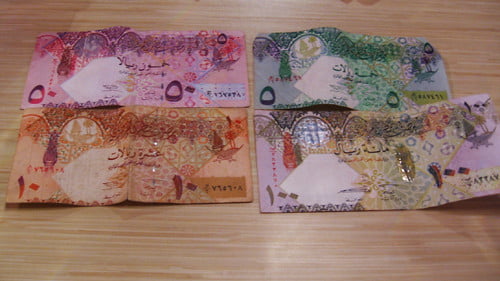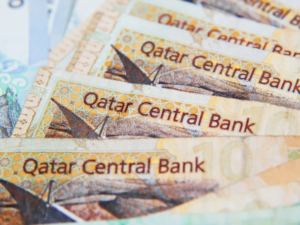History and Facts about Qatar Currency

Currency, an indispensable tool for trade and societal progress, has evolved through epochs, adapting to the changing tides of human civilization. Qatar, nestled in the cradle of antiquity, boasts a rich tapestry of monetary heritage intricately woven into its historical fabric. From the ancient barter systems that once defined early Qatari trade to the modern-day financial infrastructure, the evolution of Qatar’s currency mirrors its journey through time. The Qatar Currency Board, established in 1966, laid the groundwork for the country’s monetary governance, paving the way for the introduction of the Qatari Riyal. As the cornerstone of Qatar’s economic landscape, the Qatari Riyal (QAR) symbolizes stability and growth. Pegged to the US dollar since 1980, it has become a beacon of confidence in the global financial arena. The Riyal’s denominations, adorned with cultural motifs and national symbols, reflect Qatar’s rich heritage and aspirations. In today’s interconnected world, exploring Qatar’s currency is paramount for investors, tourists, and citizens alike. Its exchange rates, managed by the Qatar Central Bank, influence international trade and investment flows, shaping the country’s economic trajectory. In essence, the story of Qatar Currency is a testament to resilience, innovation, and the enduring spirit of a nation striving for prosperity amidst the ebb and flow of history.
Brief description of Qatari Riyal (QAR):
Since 1967, the official Qatar Currency has been the Qatari Riyal, often known as the Riyal of Qatar or Rial of Qatar (ISO code QAR). The Central Bank of Qatar issues the Riyal, equivalent to 100 Dirhams. The Saudi Riyal was in use for a brief time prior to reform, and then it was finally adopted in Qatar and Dubai. Prior to its devaluation, the Qatari Riyal was fixed at a 1:1 exchange rate with the Indian rupee, while the Saudi Riyal was set at 1,065 rupees. Dubai and Qatar jointly printed the Riyal up until 1973. However, once Dubai joined the UAE, Qatar continued to print the Riyal, whereas Dubai switched to the Emirati Dirham.
Origin of the Currency:
Between 644 and 656 CE, most commonly referred to as CE, was the beginning of the Uthman Caliphate period. If there is one thing that has persisted throughout the lengthy history of the State of Qatar’s money, from the caliphate era to the present, it is the coin’s name, Dirham, which continues to be used today. In the reign of Caliph Omar, the bimetallic Dirham standards were created. The other coin at the time that was utilised similarly was the dinar. In the Muslim world, the Dirham (silver) and Dinar (gold) continued to be used as currency for commerce and other purposes for about 1,500 years.
Legal approval:
The consistency in the appearance of these Islamic coins occurred during the Omar caliphate era, when the Dirham was legally sanctioned to be manufactured of pure silver and weighing 3 grams.
These Islamic coins served as the foundation for national and international trade in the Middle East, as well as transactions across much of the world, according to historical sources and its use have been seen by multiple nationalities and tribes.
Arab coins have been discovered in Russia and as far north as the Baltic nations. Slowly, paper currency, which was first introduced to the world by China during the reign of the Gaykhatu Empire, began to make its way into the mainstream during the Ottoman Caliphate, around the 19th century in Turkey, where they printed notes for the first time in 1842. This was the commencement of the world’s currency notes. Although paper money was originally opposed by Sharia Law, it was finally tolerated owing to global trade and rising demand.
The Qatari Riyal: An Introduction (QAR):
When Dubai joined the United Arab Emirates in 1973, the currency of Qatar, the Qatari Riyal replaced the Qatar and Dubai Riyals (UAE). Qatar began issuing its Riyal separately at this time. The Qatar and Dubai Riyals entered into force in 1966, replacing the previous currency, the Indian rupee, which had been devalued by India.
The Riyal is tied to the US dollar (USD) at a rate of 3.64 QAR to one USD, or USD/QAR = 3.64. The peg became official in 2001, when it was made a Royal Decree. According to the legislation, the currency would be kept within a range of 3.6385 and 3.6415 Riyals per USD.
Because Qatar’s economy is primarily reliant on commodities such as oil and natural gas, pegging the Qatari Riyal lessens possible economic shocks because commodity prices are priced in US dollars. The oil and gas industry accounts for the vast bulk of Qatar’s GDP (GDP).
The Qatari Riyal has bill denominations of one, five, ten, fifty, one hundred, and five hundred Riyals. The coin denominations are one, five, ten, twenty-five, and fifty Dirhams.

Fluctuation of the Qatar currency:
In 2017, the value of the Qatari Riyal (currency of Qatar) underwent a significant change in the offshore market. The reason behind this was some foreign countries deciding to halt their dealings with Qatari banks. As a result, there was a liquidity deficit that led to the Riyal falling to 3.81 in certain foreign markets.
However, the beginning of 2021 brought a positive change as Saudi Arabia, Egypt, the United Arab Emirates (UAE), and Bahrain signed a “solidarity and stability” pact. This pact brought an end to the diplomatic crisis against Qatar.






